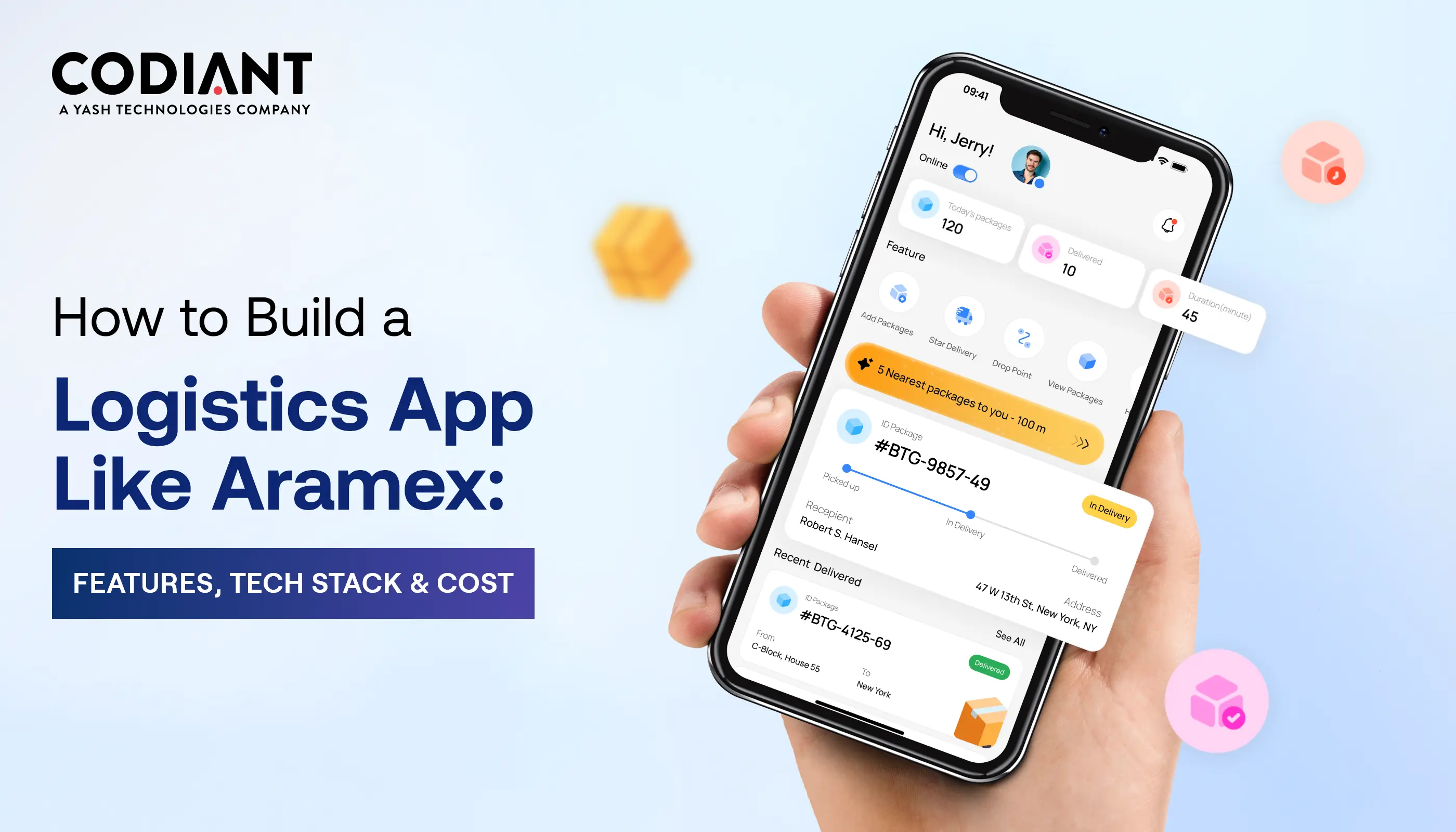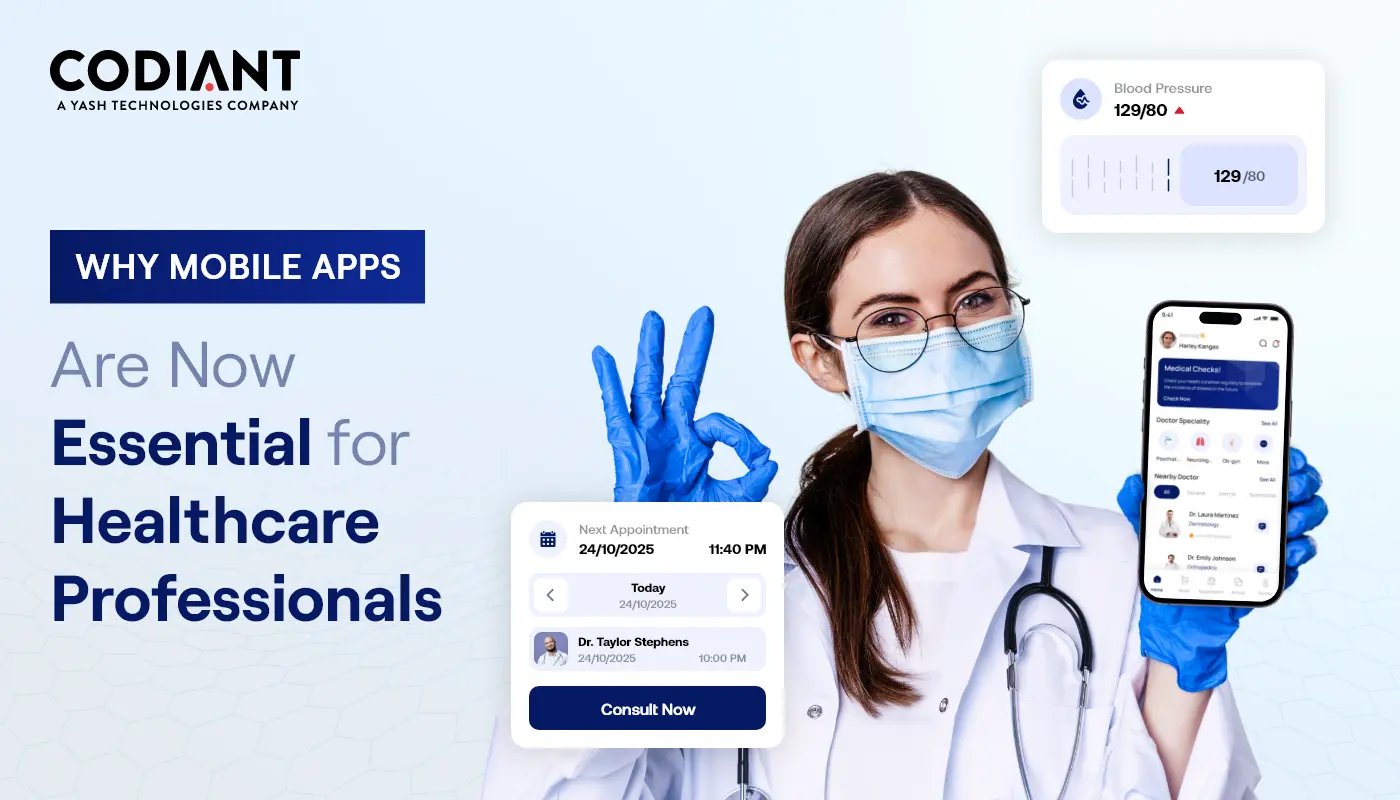AI Voice Bots in 2025: A Complete Guide & How to Use Them
Table of Contents
Subscribe To Our Newsletter

Remember the old days of calling a company? You dial, listen to a robotic voice, press 1 for billing, 2 for support, 3 to repeat the same information you’ve already entered online. By the end of it, you’re frustrated, the agent is frustrated, and the whole thing feels like a complete waste of time.
That was the reality of IVR (Interactive Voice Response) systems: rigid, scripted, and often more of a barrier than a solution.
Now imagine it’s 2025. You say: “I think there’s a wrong charge on my account.” Within seconds, a voice on the other end responds naturally. It doesn’t just parrot back canned responses, it recognizes the urgency in your tone, pulls up your account history, and offers you clear next steps.
No menus. No waiting. No hold music looping for half an hour. Just real help, instantly.
That’s the leap voice technology has taken. Today’s AI-powered voice bots, built on generative AI and large language models, don’t just understand words. They understand context, intent, and even emotion. They can handle multi-turn conversations, switch topics smoothly, and respond with empathy.
For businesses, this shift is more than a technological upgrade—it’s a communication revolution. Companies that adopt voice bots report up to 35% lower service costs while delivering 24/7 availability without compromising on service quality.
For customers, it’s seamless. For companies, it’s measurable ROI.
And in 2025’s competitive digital economy, this isn’t optional. It’s survival.
AI Voice Bots Statistics for 2025: Market Size, Adoption and Usage
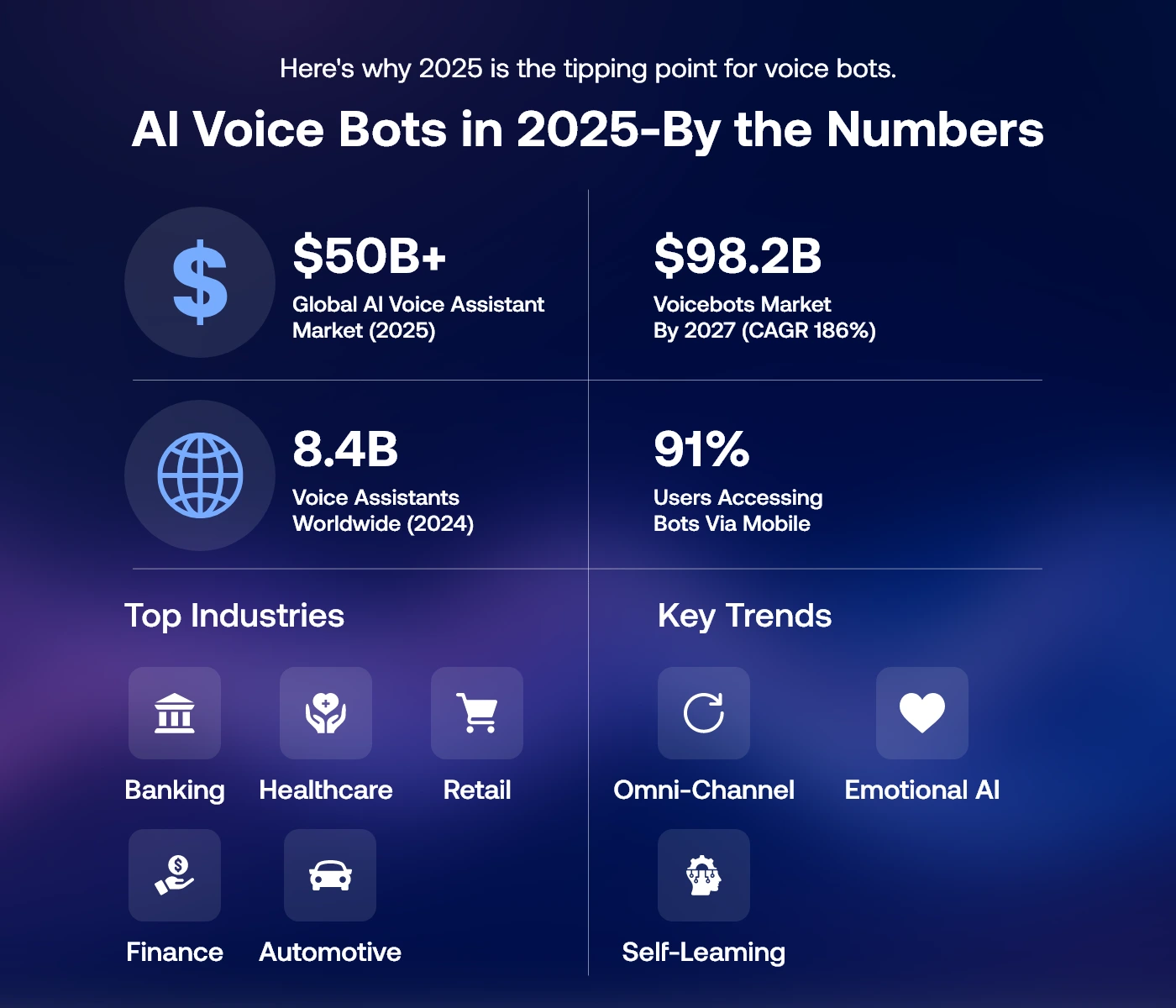
The numbers alone tell the story. By 2025, the global AI voice assistant market is projected to surpass $50 billion, with the broader voicebots segment racing toward $98.2 billion by 2027 at a CAGR of nearly 19%.
Adoption has exploded; there were already 8.4 billion voice assistants worldwide by 2024, and usage is only accelerating as voice becomes the most natural human-computer interface.
From healthcare and banking to retail, finance, and automotive, nearly half of top industry leaders are already deploying voice or chat assistants. Smartphones dominate this shift, with 91% of users accessing bots through mobile devices, making them the everyday companion for billions.
What’s fueling this growth? Omni-channel integration, emotional intelligence, and self-learning capabilities are transforming bots from simple tools into strategic assets that continuously refine themselves and deliver hyper-personalized experiences.
Every Day You Delay, Thousands of Conversations Slip Away.
Your customers aren’t waiting for you to catch up. They’re already talking to competitors offering instant AI-driven service. Each missed call is more than lost revenue—it’s lost trust.
At Codiant, we help brands turn voice automation into a strategic asset. From empathetic customer support to revenue-generating AI workflows, we build solutions that deliver real results.
Understanding AI Voice Bots: Technology and Capabilities
What Are AI Voice Bots?
Think of IVR systems as scripted actors. They followed a rigid script, and if you went off it, they broke down. AI voice bots in 2025 are improvisers. They adapt, respond, and even remember.
Picture this: you call your airline and say, “Hey, I think my flight got rescheduled, and I need options.” An IVR would have trapped you in a menu of numbers. Today’s AI bot understands the request immediately. It checks your ticket, recognizes you’re probably anxious, and gives you options to rebook.
That’s because AI voice bots combine ASR, NLP, LLMs, and generative AI to deliver conversations that feel natural. They don’t just understand what you say. They understand what you mean.
Core Technologies Powering AI Voice Bots
Here’s the tech stack that makes these bots sound so human:
- ASR (Automatic Speech Recognition): The “ears.” Converts speech into text even with accents, background noise, or imperfect pronunciation.
- NLP (Natural Language Processing): The “brain.” Goes beyond keywords to understand meaning, sentiment, and intent.
- LLMs (Large Language Models): The “knowledge.” Generates thoughtful, personalized responses, not rigid scripts.
- TTS (Text-to-Speech): The “voice.” Produces natural, expressive speech that pauses, emphasizes, and adjusts tone.
Together, these technologies erase the robotic feel of old systems and deliver real conversations.
AI Voice Bots vs. Traditional IVR Systems
Here’s the difference in one line: IVRs made you adapt to them. AI voice bots adapt to you.
Where IVRs were decision trees—press the right button or fail—voice bots are conversationalists. They handle complex, multi-part questions, switch contexts mid-call, and provide solutions without needing a human handoff every time.
How AI Voice Bots Work: The Technical Process
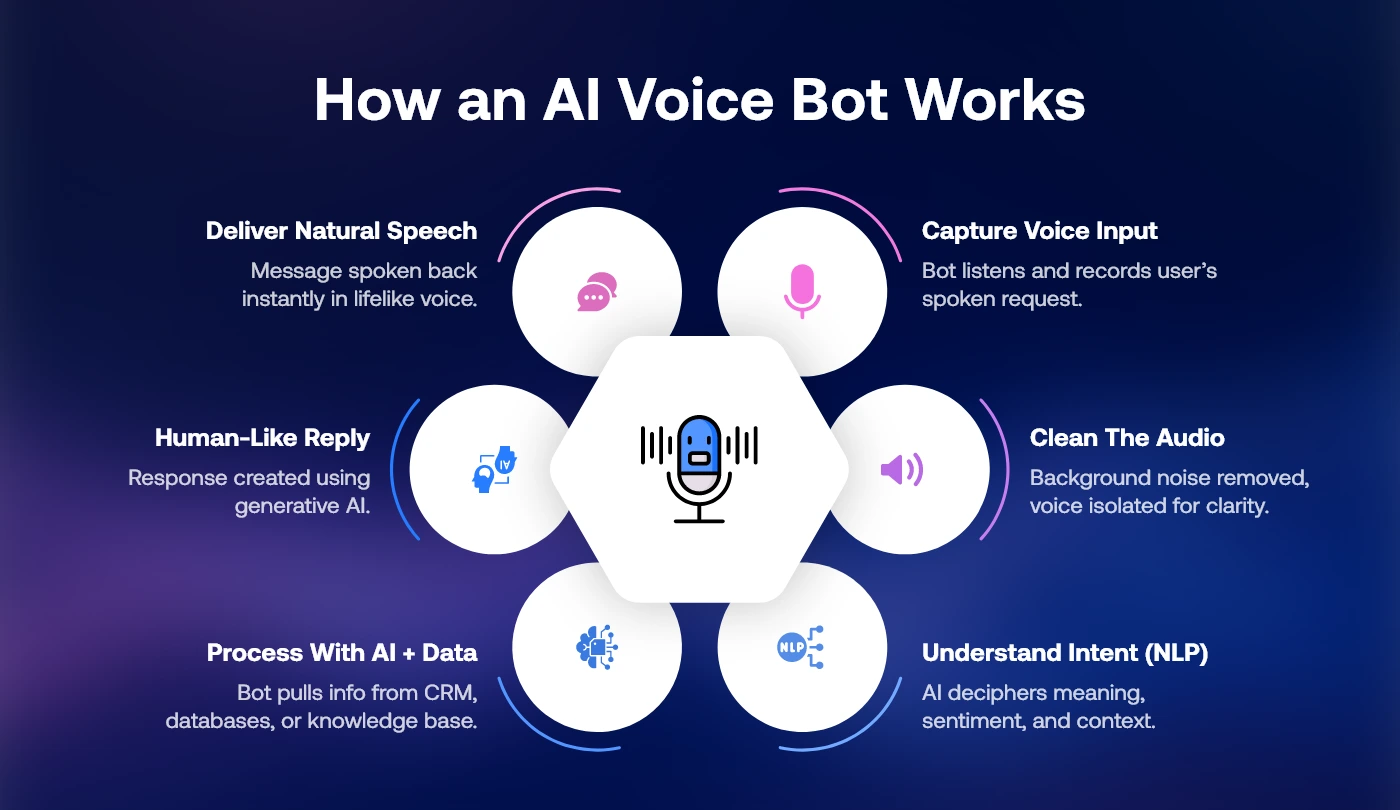
So how do they actually pull this off? It’s simpler than it sounds:
- Voice Recognition: ASR listens and converts spoken words into text, handling noise and accents.
- Audio Cleaning: Background noise is filtered out to ensure clear, accurate transcription.
- Intent Analysis: NLP deciphers what you mean, not just what you said. Example: “I need my refund back, this is ridiculous” → Refund + frustration detected.
- Response Generation: The bot uses generative AI + business data to produce a personalized, relevant answer.
- Speech Synthesis: The answer comes back as natural voice: calm, polite, and human-like.
And here’s the kicker: bots integrate with your systems. They don’t just “chat.” They cancel bookings, process payments, and update CRMs—things IVRs could never do.
Types of AI Voice Bots: Choosing the Right Solution
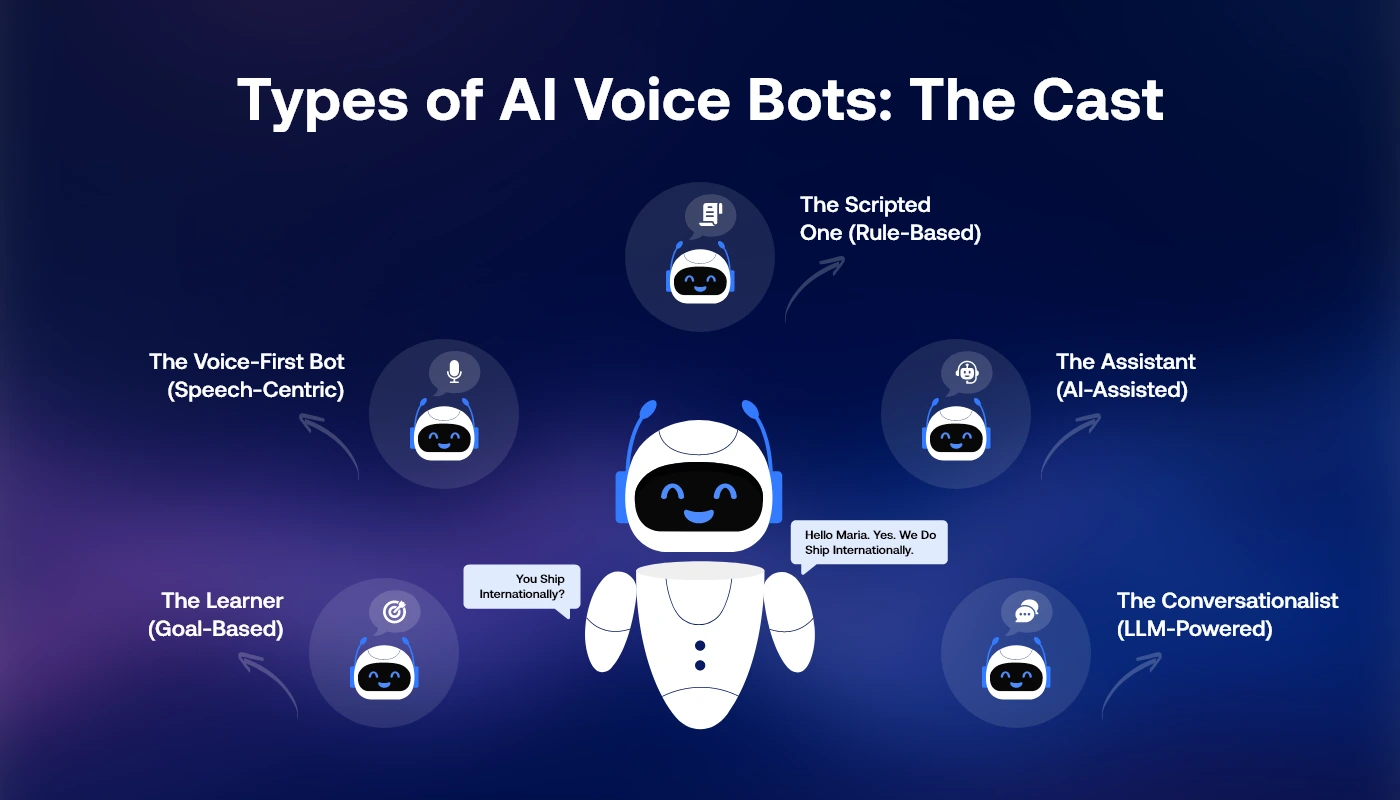
Not all bots are created equal. Think of them as characters in a cast:
- The Scripted One (Rule-Based): Works for FAQs. Cheap but limited.
- The Assistant (AI-Assisted): Can handle flexible requests like scheduling. Smarter, but still structured.
- The Conversationalist (LLM-Powered): Handles complex customer interactions, complaints, and upsells with nuance.
- The Learner (Goal-Based): Focuses on KPIs like reducing call times or boosting conversion, adapting continuously.
- The Voice-First Bot (Speech-Centric): Built for natural voice conversations, powered by ASR, TTS, and NLP—ideal for call centers, healthcare, and retail.
Choosing depends on your industry, customer needs, and growth goals.
Read more: How To Build A Chatbot with Natural Language Processing?
Business Benefits: Why AI Voice Bots Drive ROI
AI voice bots aren’t just about cutting costs or replacing wait times. They’re about creating real business lift. Imagine scaling your support without hiring armies of agents, serving customers at 3 a.m. with the same warmth as 3 p.m., and never worrying about burnout, training gaps, or “bad days.” That’s the new baseline. But it goes further, these bots remember past conversations, adapt on the fly, and even kick off tasks like scheduling or payments without human hand-holding. The result? Lower overhead, happier customers, and a business that runs leaner, faster, smarter.
A. Operational Excellence
- 24/7 Support: Always on, always ready.
- Scalability: Handle thousands of calls at once.
- Cost Savings: Reduce labor and training expenses.
- Consistency: No “bad days” like human agents.
B. Customer Experience
- Natural Conversations: Feels human, not robotic.
- Personalization: Remembers history, tailors responses.
- Instant Answers: No more waiting.
- Trust & Loyalty: Positive experiences drive repeat business.
C. Business Process Automation
-
- Proactive Outreach: Bots can call customers with updates.
- Lead Qualification: Screen and route prospects.
- Insight Collection: Gather customer data for analysis.
- Workflow Optimization: Automate repetitive tasks, freeing human agents
40% Faster Resolutions. 63% Higher Retention. Real Results.
That’s what businesses are reporting after deploying AI voice bots that leverage RAG for more accurate and contextual responses. Faster responses mean happier customers. Smarter workflows mean lower costs. And automation means your staff can finally focus on what matters.
At Codiant, we design voice automation systems tuned to your industry, your customers, and your KPIs. We don’t build “just another bot”—we build your digital frontline agent.
Industry Use Cases: How Different Sectors Win with AI Voice Bots
-
Banking & Financial Services
Banks use AI bots to verify transactions, handle balance inquiries, and flag suspicious activity. Case in point: A U.S. credit union reduced fraud detection time by 70% after deploying an AI bot that identified unusual transaction patterns in real time.
-
Healthcare
Hospitals use bots for appointment scheduling, prescription reminders, and patient triage. Case study: A New York hospital deployed voice bots during flu season, reducing average call wait times from 20 minutes to under 2.
-
Travel & Hospitality
Airlines and hotels rely on bots for booking changes, loyalty programs, and itinerary updates. Example: A European airline saw a 25% drop in call center costs after shifting rebooking calls to voice automation.
-
Retail & E-Commerce
Bots track orders, handle returns, and suggest upsells. Case: An e-commerce giant introduced a bot that not only resolved queries but suggested add-ons mid-conversation—driving a 15% increase in cross-sell revenue.
-
Telecom
Providers use bots for bill payments, technical support, and outage updates. Example: An Indian telecom provider automated 60% of Tier-1 calls, reducing customer churn by 12% in one year
-
Education
Universities and EdTech platforms use bots for admissions queries, course registrations, and student support.
Example: A leading online learning platform introduced AI voice assistants to handle 40% of student queries, freeing faculty and staff to focus on deeper academic engagement. -
Real Estate
Agencies and property platforms use bots for lead qualification, property inquiries, and scheduling viewings. Case: A U.K. real estate agency deployed a voice bot to handle rental inquiries and appointment bookings, resulting in a 30% increase in qualified leads and faster closing cycles
Implementation Guide: Deploying AI Voice Bots Successfully
A. Platform Selection
Evaluate vendors based on integration, scalability, customization, and compliance. Some (like Cognigy or VoiceSpin) are enterprise-ready. Others (like Synthflow) are faster to deploy for smaller teams.
B. Conversation Design
Don’t try to automate everything. Start with high-value use cases (like billing queries or scheduling), design natural flows, and test them with real users.
C. Training & Integration
Connect bots to your CRM, databases, and workflows. Give them a brand-aligned voice persona. Train them with real-world scenarios—accents, slang, background noise.
D. Monitoring & Optimization
Track KPIs: CSAT, resolution rates, escalation frequency, cost per interaction. Run A/B tests. Continuously update the knowledge base.
Best Practices for Maximum Success
- Keep it conversational. If it sounds like a robot, you’ve already lost.
- Always allow easy escalation to humans.
- Collect and act on customer feedback.
- Don’t start too big. Solve one problem brilliantly, then expand.
- Keep compliance and security airtight—voice data is sensitive
Measuring Success
You can’t improve what you don’t measure. Track:
- Customer Experience: CSAT, NPS, first-contact resolution.
- Business Impact: Cost savings, upsell revenue, churn reduction.
- Technical Performance: Accuracy, speed, uptime.
When done right, enterprises report 15–20% revenue growth from AI voice bots through better efficiency and customer loyalty.
Read more: How Are Voice Bots in the Banking Sector Redefining Customer Service
Future Trends: What’s Next for AI Voice Bots?
- Emotional Intelligence at Scale: Bots that can detect stress, joy, or frustration and adjust tone dynamically.
- Multimodal Conversations: Voice bots combined with visual AI—imagine your bot sending follow-up links, receipts, or explainer videos while talking.
- Hyper-Personalization: Using customer history + predictive analytics to anticipate needs before you ask.
- Proactive Voice Commerce: Bots that don’t just respond but initiate. “Your subscription is expiring, would you like me to renew?”
- Cross-Channel Continuity: Pick up a conversation started on WhatsApp and continue it over a voice call—no context lost.
These trends point to a world where AI voice bots don’t just support customer experience—they define it.
Conclusion: Embracing the Future of Communication
Voice bots aren’t built to replace humans, they’re designed to replace long wait times, confusing menus, and customer frustration. Created with precision by an expert AI developers, these bots deliver instant, personalized responses that keep users engaged and satisfied. They empower customer service teams to focus on empathy-driven interactions while helping businesses scale efficiently—boosting growth without increasing operational costs.
The question isn’t if voice bots will define the future of customer service. It’s whether you’ll be ahead—or playing catch-up.
Every Month You Wait, Competitors Take the Lead
Delaying AI adoption doesn’t just slow you down—it hands customers to someone else. With Codiant, you can launch secure, scalable, and revenue-focused voice bots in weeks, not years.
At Codiant, This is your chance to turn every call into a moment of trust, loyalty, and conversion.
Featured Blogs
Read our thoughts and insights on the latest tech and business trends
How to Build a Logistics and Transportation App Like Aramex?
- November 6, 2025
- Logistics & Transportation
In a Nutshell: A logistics app like Aramex helps businesses manage deliveries, track shipments, and serve customers better. Technology is now needed in logistics because customers want fast delivery and real-time tracking. A logistics app... Read more
How to Modernize Legacy Systems with AI – A Step-by-Step Guide
- October 31, 2025
- Artificial Intelligence
In a Nutshell: Legacy systems aren’t outdated - they’re underutilized. AI can modernize them without full replacement, saving time and cost. Modernization is a journey, not a rebuild. Start small with automation, data clean-up &... Read more
Top Reasons Why Healthcare Providers Need Mobile Apps Today
- October 27, 2025
- Healthcare
If you’ve been to a clinic lately, you might have noticed something new-paper forms are almost gone and screens are everywhere. From booking doctor visits online to checking your recovery updates on your phone mobile... Read more

